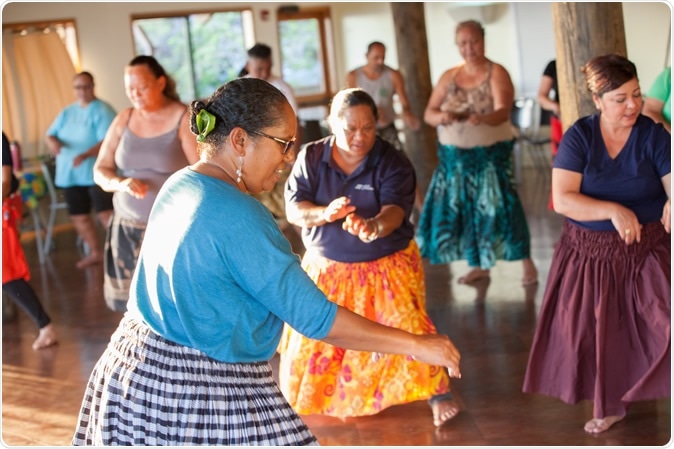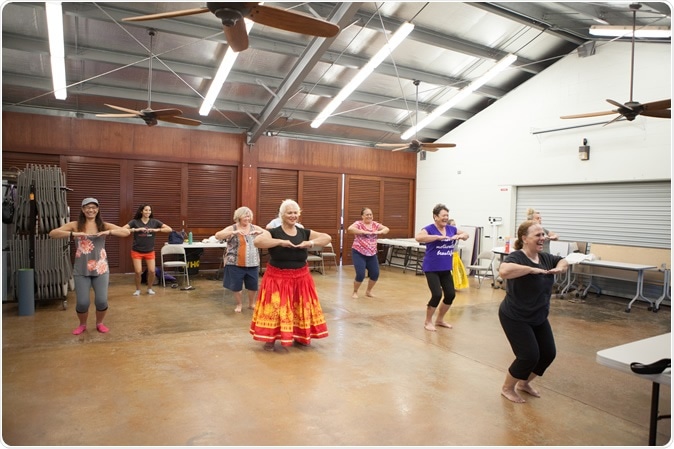
Hula instructor leading class, Kumu hula (Hula teacher) Kamanaʻo Manoa-Hyde leading her class. Waiʻanae Coast Comprehensive Health Center. Copyright Nicasello Photography
Physical activity or exercise can markedly decrease the risk of chronic diseases, including high blood pressure. A new study found that hula dancing, a famous type of dance in Hawaii, has been linked to a lower blood pressure reading.
A team of researchers at the University of Hawaii found that native Hawaiians who engaged in a blood-pressure-lowering program including their cultural dance of hula significantly lowered their blood pressure, compared to those who received a standard education on exercise and diet.
The study, which was presented at the American Heart Association’s (AHA) Hypertension 2019 Scientific Sessions, shows that despite taking their medicines for hypertension, many Native Hawaiians have problems in controlling their hypertension, which heightens their risk of developing stroke and coronary heart disease.
“The rates of heart disease and stroke are four times higher among Native Hawaiians than in non-Hispanic whites, and they also get these diseases ten years younger than whites and Asians in Hawaii,” Dr. Keawe'aimoku Kaholokula, professor of the department of Native Hawaiian health at the University of Hawaii, said.
Lifestyle programs to curb hypertension
The results don’t come as a surprise. In a previous study by Kaholokula and his team discovered that Native Hawaiians are not attracted to traditional lifestyle programs geared toward lowering blood pressure. Many of them think that the programs and some activities in it are expensive or boring. Also, the dietary goals are unrealistic and hard to maintain for a long time.

Hula dance class with instructor, Hula teacher (kuma hula) Ka’olu Luning, Ke Ola Mamo Health Systems Medical Clinic, Honolulu, HI. Copyright Nicasello Photography
The team found that Native Hawaiians prefer group-based and culturally relevant lifestyle interventions. Hence, the researchers formulated an intervention based on hula, which can be performed at varying levels of intensity and difficulty by everyone of all ages.
Hula dancing linked to lower blood pressure
To land to their findings, the researchers recruited more than 250 Native Americans who, even if undergoing medical treatment for hypertension, still had a high systolic blood pressure of 140mmHg or had a systolic blood pressure reading of 130mmHG and had type 2 diabetes.The team recruited 263 Native Hawaiians from nine communities on three islands. The participants attended three-hour sessions of hypertension education, including information on exercise, diet, and the use of medications in a week for three months. After which, they attended a monthly lesson for three more months. The lessons included self-directed practice and group activities to strengthen healthy behaviors and hypertension education.
The findings show that those who engaged in the program with hula dancing had lower blood pressure readings far below what those who were not assigned to the hula group were able to attain. Plus, the hula group participants decreased their 10-year risk of getting heart disease. They were also able to maintain improvements in their health, particularly blood pressure even after one year, which was six months after the hula dance classes ended.
“The participants said the hula was fun and helped meet their spiritual and cultural needs,” Kaholokula said. “More than 80 percent stayed with the program for six months, and 77 percent were still at it 12 months in, which reflects a high interest in a culturally grounded program like this.,” he added.
The results of the study emphasize that the best physical activity people do should be something to make them breathe a little faster, to help get the heart beating a little faster, too.
“Whether that’s dancing, biking, swimming, surfing, or hiking, the key is to move more and more often. Being active with friends and family can help sustain the healthy fun over time,” Dr. David Goff, Director of the Division of Cardiovascular Sciences at the National Heart, Lung, and Blood Institute, part of the National Institutes of Health which funded the study, said.
What lifestyle changes can help reduce hypertension?
To manage hypertension or high blood pressure, people should take care of their health. There are many ways to improve one’s health and prevent complications of hypertension from developing.These include:
- Eating a well-balanced diet, particularly a diet low in salt content
- Effectively managing stress
- Maintaining a healthy weight
- Engaging in physical activity or exercise
- Limiting alcohol intake
- Quitting smoking
- Taking medications as prescribed
- Working with your doctor and health care providers
Journal reference:
American Heart Association (AHA). (2019). Native Hawaiians lowered blood pressure with hula dancing. https://newsroom.heart.org/news/native-hawaiians-lowered-blood-pressure-with-hula-dancing?preview=c7e8






No comments
Post a Comment